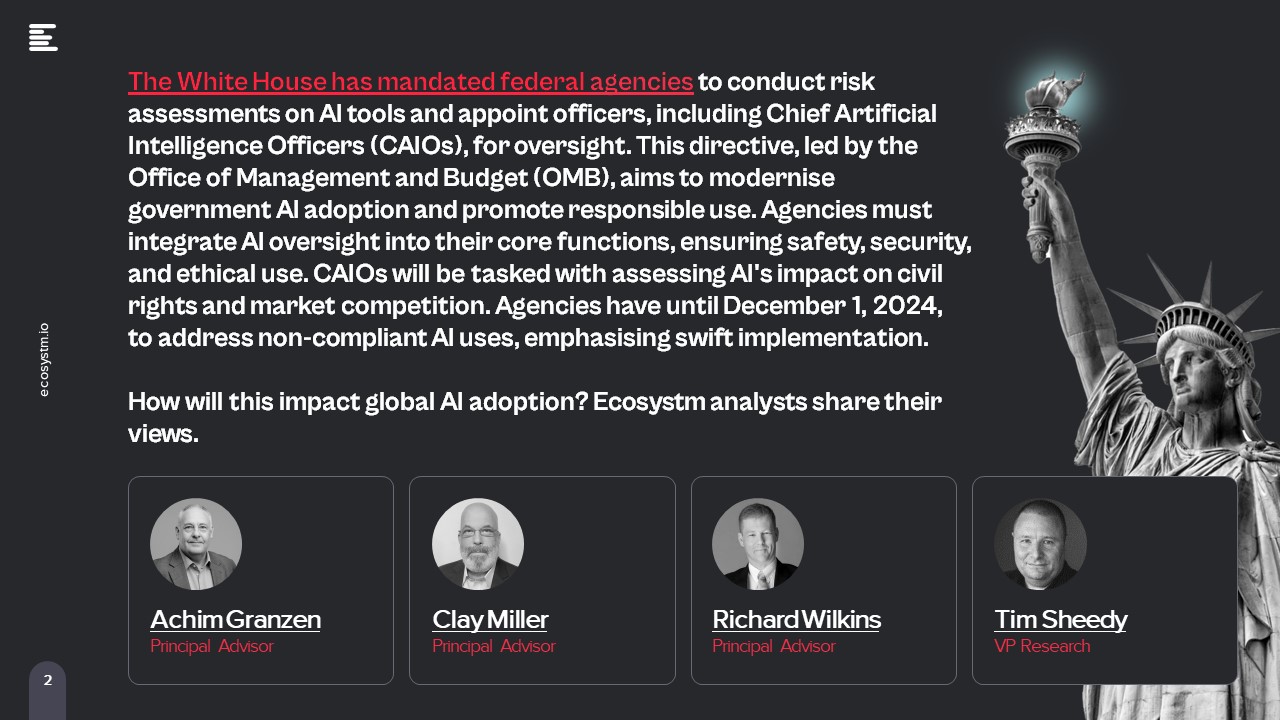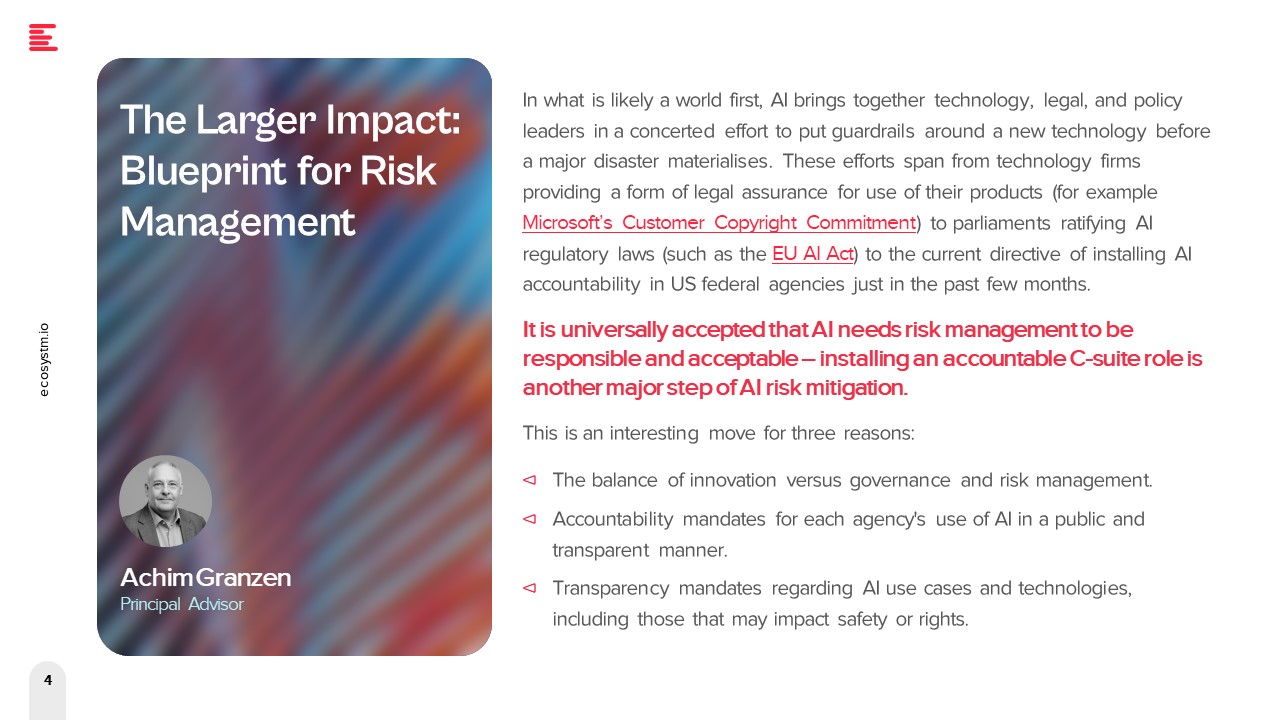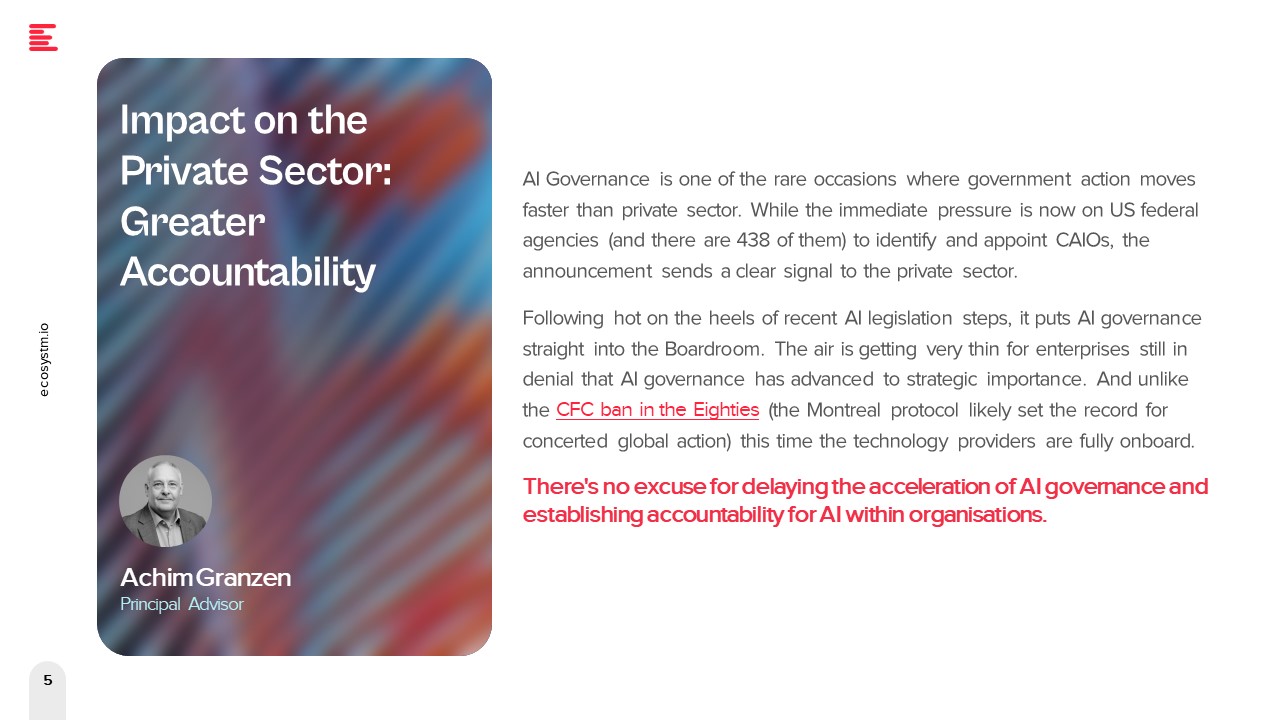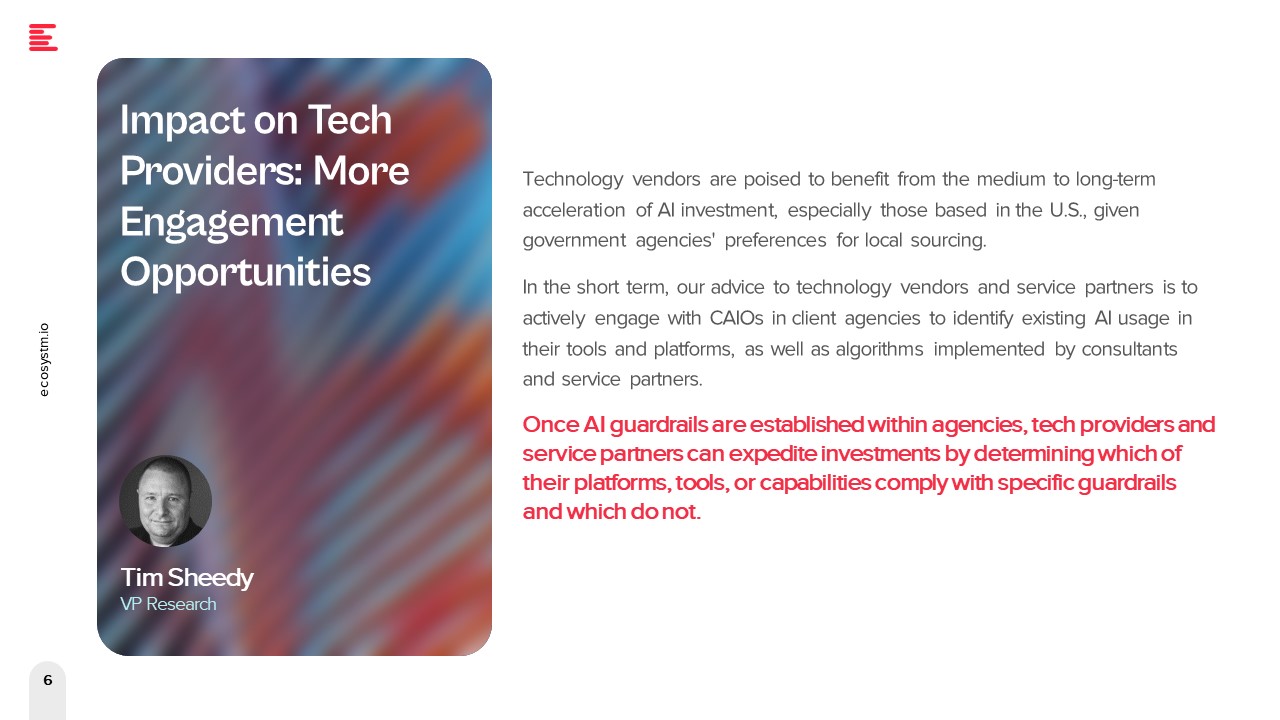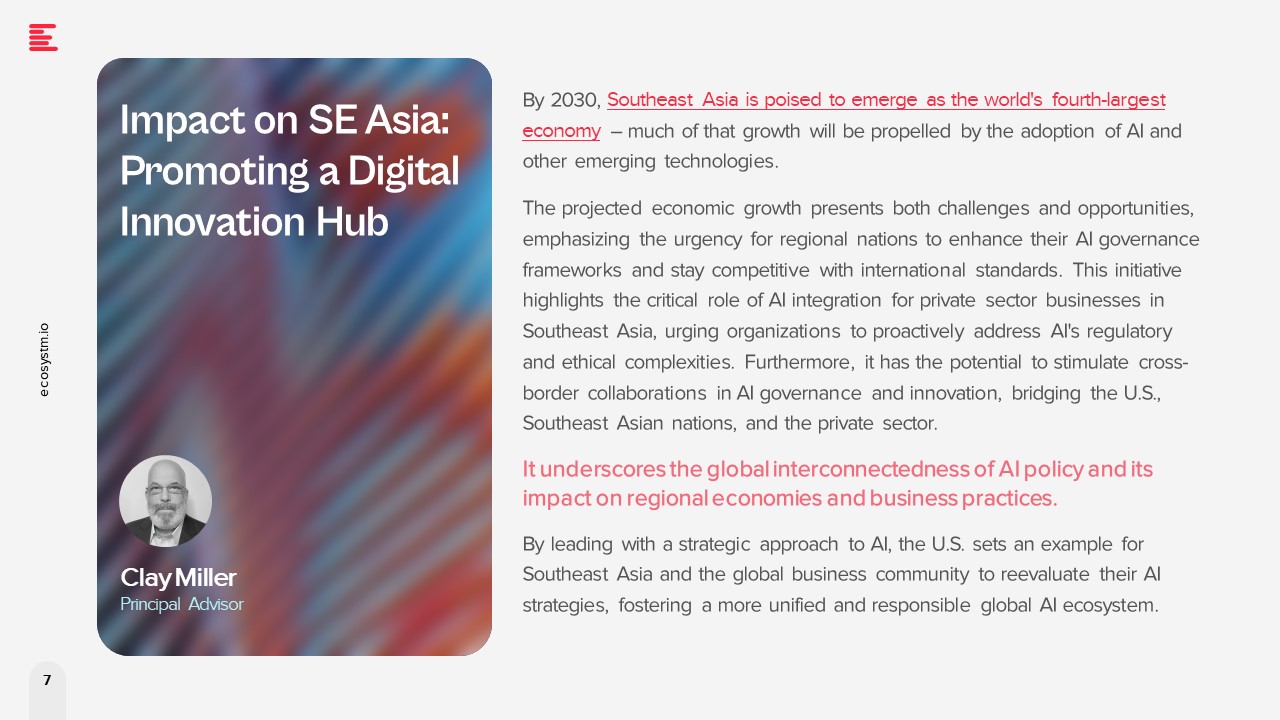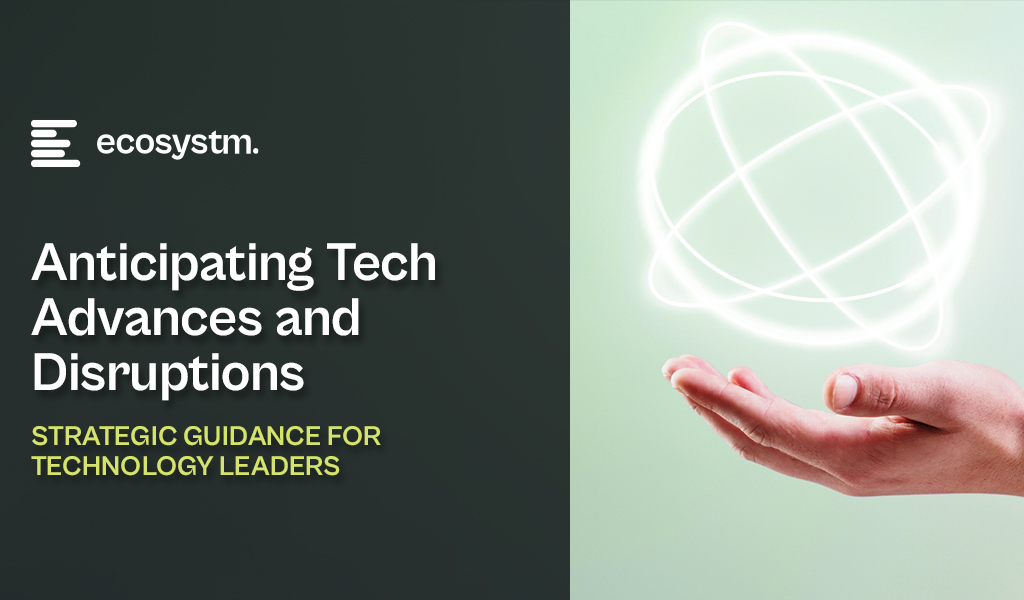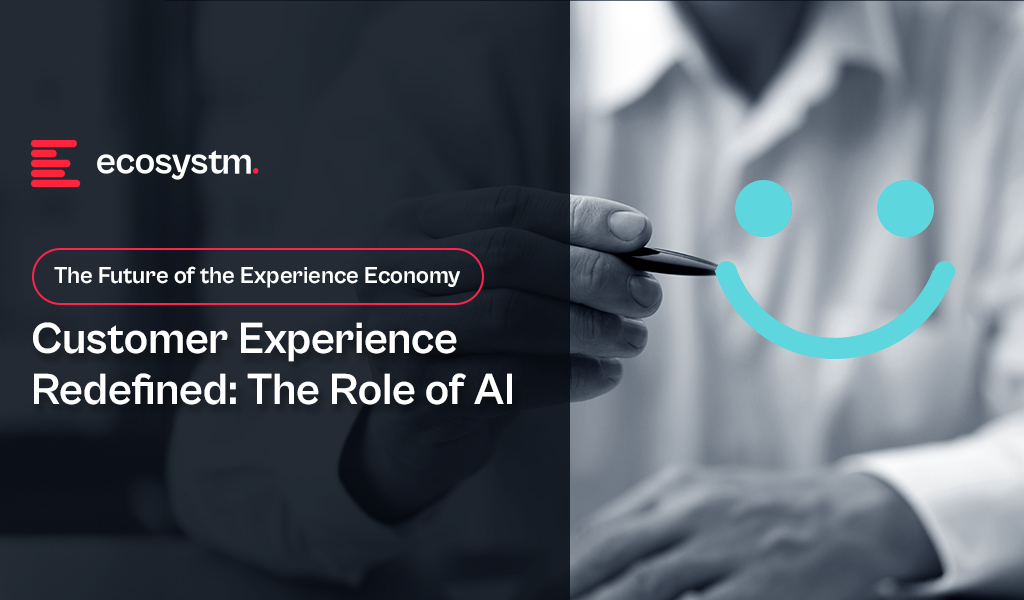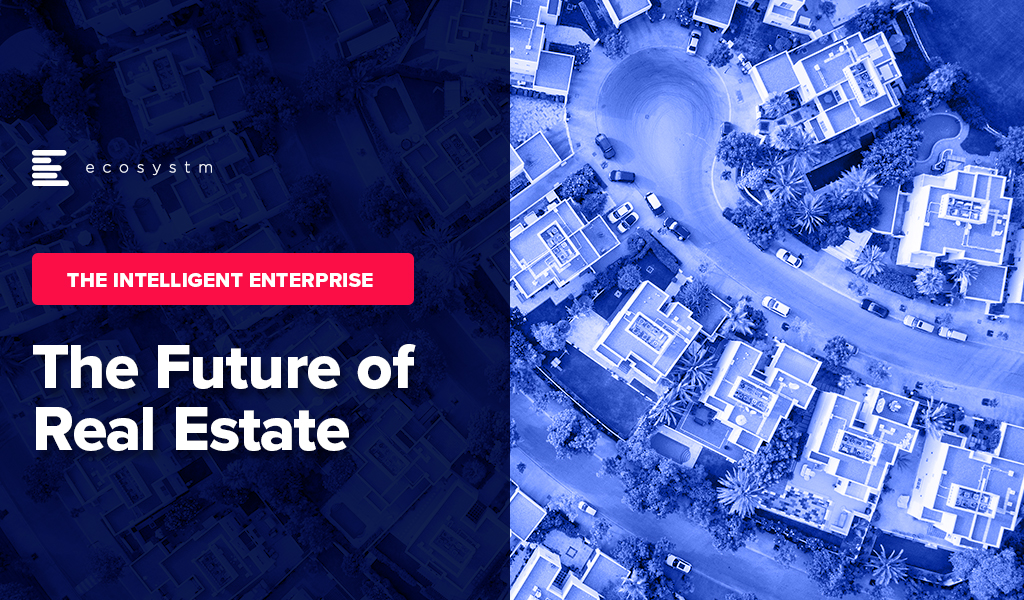The White House has mandated federal agencies to conduct risk assessments on AI tools and appoint officers, including Chief Artificial Intelligence Officers (CAIOs), for oversight. This directive, led by the Office of Management and Budget (OMB), aims to modernise government AI adoption and promote responsible use. Agencies must integrate AI oversight into their core functions, ensuring safety, security, and ethical use. CAIOs will be tasked with assessing AI’s impact on civil rights and market competition. Agencies have until December 1, 2024, to address non-compliant AI uses, emphasising swift implementation.
How will this impact global AI adoption? Ecosystm analysts share their views.
Click here to download ‘Ensuring Ethical AI: US Federal Agencies’ New Mandate’ as a PDF.
The Larger Impact: Setting a Global Benchmark

This sets a potential global benchmark for AI governance, with the U.S. leading the way in responsible AI use, inspiring other nations to follow suit. The emphasis on transparency and accountability could boost public trust in AI applications worldwide.
The appointment of CAIOs across U.S. federal agencies marks a significant shift towards ethical AI development and application. Through mandated risk management practices, such as independent evaluations and real-world testing, the government recognises AI’s profound impact on rights, safety, and societal norms.
This isn’t merely a regulatory action; it’s a foundational shift towards embedding ethical and responsible AI at the heart of government operations. The balance struck between fostering innovation and ensuring public safety and rights protection is particularly noteworthy.
This initiative reflects a deep understanding of AI’s dual-edged nature – the potential to significantly benefit society, countered by its risks.
The Larger Impact: Blueprint for Risk Management

In what is likely a world first, AI brings together technology, legal, and policy leaders in a concerted effort to put guardrails around a new technology before a major disaster materialises. These efforts span from technology firms providing a form of legal assurance for use of their products (for example Microsoft’s Customer Copyright Commitment) to parliaments ratifying AI regulatory laws (such as the EU AI Act) to the current directive of installing AI accountability in US federal agencies just in the past few months.
It is universally accepted that AI needs risk management to be responsible and acceptable – installing an accountable C-suite role is another major step of AI risk mitigation.
This is an interesting move for three reasons:
- The balance of innovation versus governance and risk management.
- Accountability mandates for each agency’s use of AI in a public and transparent manner.
- Transparency mandates regarding AI use cases and technologies, including those that may impact safety or rights.
Impact on the Private Sector: Greater Accountability

AI Governance is one of the rare occasions where government action moves faster than private sector. While the immediate pressure is now on US federal agencies (and there are 438 of them) to identify and appoint CAIOs, the announcement sends a clear signal to the private sector.
Following hot on the heels of recent AI legislation steps, it puts AI governance straight into the Boardroom. The air is getting very thin for enterprises still in denial that AI governance has advanced to strategic importance. And unlike the CFC ban in the Eighties (the Montreal protocol likely set the record for concerted global action) this time the technology providers are fully onboard.
There’s no excuse for delaying the acceleration of AI governance and establishing accountability for AI within organisations.
Impact on Tech Providers: More Engagement Opportunities

Technology vendors are poised to benefit from the medium to long-term acceleration of AI investment, especially those based in the U.S., given government agencies’ preferences for local sourcing.
In the short term, our advice to technology vendors and service partners is to actively engage with CAIOs in client agencies to identify existing AI usage in their tools and platforms, as well as algorithms implemented by consultants and service partners.
Once AI guardrails are established within agencies, tech providers and service partners can expedite investments by determining which of their platforms, tools, or capabilities comply with specific guardrails and which do not.
Impact on SE Asia: Promoting a Digital Innovation Hub

By 2030, Southeast Asia is poised to emerge as the world’s fourth-largest economy – much of that growth will be propelled by the adoption of AI and other emerging technologies.
The projected economic growth presents both challenges and opportunities, emphasizing the urgency for regional nations to enhance their AI governance frameworks and stay competitive with international standards. This initiative highlights the critical role of AI integration for private sector businesses in Southeast Asia, urging organizations to proactively address AI’s regulatory and ethical complexities. Furthermore, it has the potential to stimulate cross-border collaborations in AI governance and innovation, bridging the U.S., Southeast Asian nations, and the private sector.
It underscores the global interconnectedness of AI policy and its impact on regional economies and business practices.
By leading with a strategic approach to AI, the U.S. sets an example for Southeast Asia and the global business community to reevaluate their AI strategies, fostering a more unified and responsible global AI ecosystem.
The Risks

U.S. government agencies face the challenge of sourcing experts in technology, legal frameworks, risk management, privacy regulations, civil rights, and security, while also identifying ongoing AI initiatives. Establishing a unified definition of AI and cataloguing processes involving ML, algorithms, or GenAI is essential, given AI’s integral role in organisational processes over the past two decades.
However, there’s a risk that focusing on AI governance may hinder adoption.
The role should prioritise establishing AI guardrails to expedite compliant initiatives while flagging those needing oversight. While these guardrails will facilitate “safe AI” investments, the documentation process could potentially delay progress.
The initiative also echoes a 20th-century mindset for a 21st-century dilemma. Hiring leaders and forming teams feel like a traditional approach. Today, organisations can increase productivity by considering AI and automation as initial solutions. Investing more time upfront to discover initiatives, set guardrails, and implement AI decision-making processes could significantly improve CAIO effectiveness from the outset.

As AI evolves rapidly, the emergence of GenAI technologies such as GPT models has sparked a novel and critical role: prompt engineering. This specialised function is becoming indispensable in optimising the interaction between humans and AI, serving as a bridge that translates human intentions into prompts that guide AI to produce desired outcomes. In this Ecosystm Insight, I will explore the importance of prompt engineering, highlighting its significance, responsibilities, and the impact it has on harnessing AI’s full potential.
Understanding Prompt Engineering
Prompt engineering is an interdisciplinary role that combines elements of linguistics, psychology, computer science, and creative writing. It involves crafting inputs (prompts) that are specifically designed to elicit the most accurate, relevant, and contextually appropriate responses from AI models. This process requires a nuanced understanding of how different models process information, as well as creativity and strategic thinking to manipulate these inputs for optimal results.
As GenAI applications become more integrated across sectors – ranging from creative industries to technical fields – the ability to effectively communicate with AI systems has become a cornerstone of leveraging AI capabilities. Prompt engineers play a crucial role in this scenario, refining the way we interact with AI to enhance productivity, foster innovation, and create solutions that were previously unimaginable.
The Art and Science of Crafting Prompts
Prompt engineering is as much an art as it is a science. It demands a balance between technical understanding of AI models and the creative flair to engage these models in producing novel content. A well-crafted prompt can be the difference between an AI generating generic, irrelevant content and producing work that is insightful, innovative, and tailored to specific needs.
Key responsibilities in prompt engineering include:
- Prompt Optimisation. Fine-tuning prompts to achieve the highest quality output from AI models. This involves understanding the intricacies of model behaviour and leveraging this knowledge to guide the AI towards desired responses.
- Performance Testing and Iteration. Continuously evaluating the effectiveness of different prompts through systematic testing, analysing outcomes, and refining strategies based on empirical data.
- Cross-Functional Collaboration. Engaging with a diverse team of professionals, including data scientists, AI researchers, and domain experts, to ensure that prompts are aligned with project goals and leverage domain-specific knowledge effectively.
- Documentation and Knowledge Sharing. Developing comprehensive guidelines, best practices, and training materials to standardise prompt engineering methodologies within an organisation, facilitating knowledge transfer and consistency in AI interactions.
The Strategic Importance of Prompt Engineering
Effective prompt engineering can significantly enhance the efficiency and outcomes of AI projects. By reducing the need for extensive trial and error, prompt engineers help streamline the development process, saving time and resources. Moreover, their work is vital in mitigating biases and errors in AI-generated content, contributing to the development of responsible and ethical AI solutions.
As AI technologies continue to advance, the role of the prompt engineer will evolve, incorporating new insights from research and practice. The ability to dynamically interact with AI, guiding its creative and analytical processes through precisely engineered prompts, will be a key differentiator in the success of AI applications across industries.
Want to Hire a Prompt Engineer?
Here is a sample job description for a prompt engineer if you think that your organisation will benefit from the role.

Conclusion
Prompt engineering represents a crucial evolution in the field of AI, addressing the gap between human intention and machine-generated output. As we continue to explore the boundaries of what AI can achieve, the demand for skilled prompt engineers – who can navigate the complex interplay between technology and human language – will grow. Their work not only enhances the practical applications of AI but also pushes the frontier of human-machine collaboration, making them indispensable in the modern AI ecosystem.

2024 will be another crucial year for tech leaders – through the continuing economic uncertainties, they will have to embrace transformative technologies and keep an eye on market disruptors such as infrastructure providers and AI startups. Ecosystm analysts outline the key considerations for leaders shaping their organisations’ tech landscape in 2024.
Navigating Market Dynamics

Continuing Economic Uncertainties. Organisations will focus on ongoing projects and consider expanding initiatives in the latter part of the year.
Popularity of Generative AI. This will be the time to go beyond the novelty factor and assess practical business outcomes, allied costs, and change management.
Infrastructure Market Disruption. Keeping an eye out for advancements and disruptions in the market (likely to originate from the semiconductor sector) will define vendor conversations.
Need for New Tech Skills. Generative AI will influence multiple tech roles, including AIOps and IT Architecture. Retaining talent will depend on upskilling and reskilling.
Increased Focus on Governance. Tech vendors are guide tech leaders on how to implement safeguards for data usage, sharing, and cybersecurity.
5 Key Considerations for Tech Leaders
#1 Accelerate and Adapt: Streamline IT with a DevOps Culture
Over the next 12-18 months, advancements in AI, machine learning, automation, and cloud-native technologies will be vital in leveraging scalability and efficiency. Modernisation is imperative to boost responsiveness, efficiency, and competitiveness in today’s dynamic business landscape.
The continued pace of disruption demands that organisations modernise their applications portfolios with agility and purpose. Legacy systems constrained by technical debt drag down velocity, impairing the ability to deliver new innovative offerings and experiences customers have grown to expect.
Prioritising modernisation initiatives that align with key value drivers is critical. Technology leaders should empower development teams to move beyond outdated constraints and swiftly deploy enhanced applications, microservices, and platforms.

#2 Empowering Tomorrow: Spring Clean Your Tech Legacy for New Leaders
Modernising legacy systems is a strategic and inter-generational shift that goes beyond simple technical upgrades. It requires transformation through the process of decomposing and replatforming systems – developed by previous generations – into contemporary services and signifies a fundamental realignment of your business with the evolving digital landscape of the 21st century.
The essence of this modernisation effort is multifaceted. It not only facilitates the integration of advanced technologies but also significantly enhances business agility and drives innovation. It is an approach that prepares your organisation for impending skill gaps, particularly as the older workforce begins to retire over the next decade. Additionally, it provides a valuable opportunity to thoroughly document, reevaluate, and improve business processes. This ensures that operations are not only efficient but also aligned with current market demands, contemporary regulatory standards, and the changing expectations of customers.

#3 Employee Retention: Consider the Strategic Role of Skills Acquisition
The agile, resilient organisation needs to be able to respond at pace to any threat or opportunity it faces. Some of this ability to respond will be related to technology platforms and architectures, but it will be the skills of employees that will dictate the pace of reform. While employee attrition rates will continue to decline in 2024 – but it will be driven by skills acquisition, not location of work.
Organisations who offer ongoing staff training – recognising that their business needs new skills to become a 21st century organisation – are the ones who will see increasing rates of employee retention and happier employees. They will also be the ones who offer better customer experiences, driven by motivated employees who are committed to their personal success, knowing that the organisation values their performance and achievements.

#4 Next-Gen IT Operations: Explore Gen AI for Incident Avoidance and Predictive Analysis
The integration of Generative AI in IT Operations signifies a transformative shift from the automation of basic tasks, to advanced functions like incident avoidance and predictive analysis. Initially automating routine tasks, Generative AI has evolved to proactively avoiding incidents by analysing historical data and current metrics. This shift from proactive to reactive management will be crucial for maintaining uninterrupted business operations and enhancing application reliability.
Predictive analysis provides insight into system performance and user interaction patterns, empowering IT teams to optimise applications pre-emptively, enhancing efficiency and user experience. This also helps organisations meet sustainability goals through accurate capacity planning and resource allocation, also ensuring effective scaling of business applications to meet demands.

#5 Expanding Possibilities: Incorporate AI Startups into Your Portfolio
While many of the AI startups have been around for over five years, this will be the year they come into your consciousness and emerge as legitimate solutions providers to your organisation. And it comes at a difficult time for you!
Most tech leaders are looking to reduce technical debt – looking to consolidate their suppliers and simplify their tech architecture. Considering AI startups will mean a shift back to more rather than fewer tech suppliers; a different sourcing strategy; more focus on integration and ongoing management of the solutions; and a more complex tech architecture.
To meet business requirements will mean that business cases will need to be watertight – often the value will need to be delivered before a contract has been signed.


Fintechs have carved out a niche both in their customer-centric approach and in crafting solutions for underserved communities without access to traditional financial services. Irrespective of their objectives, there is an immense reliance on innovation for lower-cost, personalised, and more convenient services.
However, a staggering 75% of venture-backed fintech startups fail to scale and grow – and this applies to fintechs as well.
Here are the 5 areas that fintechs need to focus on to succeed in a competitive market.
Download ‘Building a Successful Fintech Business’ as a PDF

The impact of AI on Customer Experience (CX) has been profound and continues to expand. AI allows a a range of advantages, including improved operational efficiency, cost savings, and enhanced experiences for both customers and employees.
AI-powered solutions have the capability to analyse vast volumes of customer data in real-time, providing organisations with invaluable insights into individual preferences and behaviour. When executed effectively, the ability to capture, analyse, and leverage customer data at scale gives organisations significant competitive edge. Most importantly, AI unlocks opportunities for innovation.
Read on to discover the transformative impact of AI on customer experiences.
Click here to download ‘Customer Experience Redefined: The Role of AI’ as a PDF

It seems for many employees, the benefits of working from home or even adopting a hybrid model are a thing of the past. Employees are returning to the grind of long commutes and losing hours in transit. What is driving this shift in sentiment? CEOs, who once rooted for remote work, have undergone a change of heart – many say that remote work hampers their ability to innovate.
That may not be the real reason, however. There is a good chance that the CEO and/or other managers feel they have lost control or visibility over their employees. Returning to a more traditional management approach, where everyone is within direct sight, might seem like a simpler solution.
The Myths of Workplace Innovation
I find it ironic that organisations say they want employees to come into the office because they cannot innovate at the same rate. What the last few years have demonstrated – and quite conclusively – is that employees can innovate wherever they are, if they are driven to it and have the right tools. So, organisations need to evaluate whether they have innovated on and evolved their hybrid and remote work solutions effectively, to continue to support hybrid work – and innovation.
What is confusing about this stance that many organisations are taking, is that when an organisation has multiple offices, they are effectively a hybrid business – they have had people working from different locations, but have never felt the need to get all their staff together for 3-5 days every week for organisation-wide innovation that is suddenly so important today.
The CEO of a tech research firm once said – the office used to be considered the place to get together to use the tools we need to innovate; but the reality is that the office is just one of the tools that businesses have, to drive their organisation forward. Ironically, this same CEO has recently called everyone back into the office 3 days a week!
Is Remote Work the Next Step in Employee Rights?
It has become clear that remote and hybrid work is the next step in employees getting greater rights. Many organisations fought against the five-day work weeks, claiming they wouldn’t make as much money as they did when employees worked whenever they were told. They fought against the 40-hour work week (in France some fought against the 35-hour work week!) They fight against the introduction of new public holidays, against increases to the minimum wages, against paid parental leave.
Some industries, companies, unions, and countries are looking to (or already have) formalised hybrid and remote work in their policies and regulations. More unions and businesses will do this – and employees will have choice.
People will have the option to work for an employer who wants their employees to come into the office – or work for someone else. And this will depend on preferences and working styles – some employees enjoy the time spent away from home and like the social nature of office environments. But many also like the extra time, money, and flexibility that remote work allows.
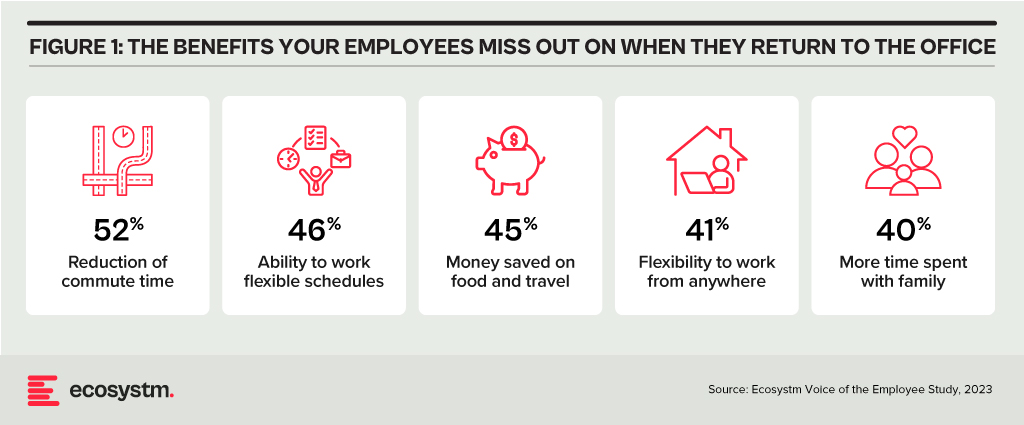
There might be many reasons why leadership teams would want employees to come into the office – and establishing and maintaining a common corporate culture would be a leading reason. But what they need to do is stop pretending it is about “innovation”. Innovation is possible while working remotely, as it is when working from separate offices or even different floors within the same building.
Evolving Employee Experience & Collaboration Needs
Organisations today face a challenge – and it is not the inability to innovate in a hybrid work environment! It is in their ability to deliver the employee experience that their employees want. This is more challenging now because there are more preferences, options, and technologies available. But it is established that organisations need to continue to evolve their employee experience.
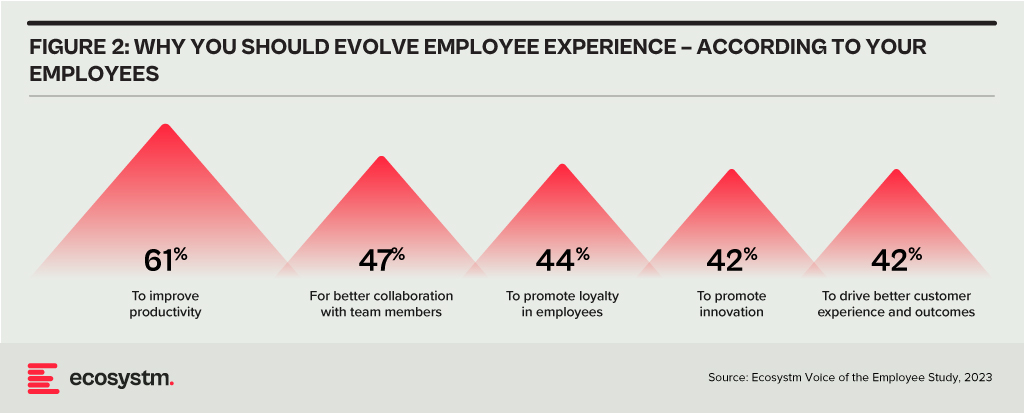
Technology does and will continue to play an important role in keeping our employees connected and productive. AI – such as Microsoft Copilot – will continue to improve our productivity. But the management needs to evolve with the technology. If the senior management feels that connecting people will help to solve the current growth challenges in the business, then it becomes the role of managers to better connect people – not just teams in offices, but virtual teams across the entire organisation.
Organisations that have focused their energies on connecting their employees better, regardless of their location (such as REA in Australia), find that productivity and innovation rates are better than when people are physically together. What do they do differently?
- Managers find their roles have moved from supporting individual employees to connecting employees
- Documentation of progress and challenges means that everyone knows where to focus their energies
- Managed virtual (and in-person) meetings mean that everyone has a voice and gets to contribute (not the loudest, most talkative or most senior person)
Remote and hybrid workers are often well-positioned to come up with new and innovative ideas. Senior management can encourage innovation and risk-taking by creating a safe environment for employees to share their ideas and by providing them with the resources they need to develop and implement their ideas. Sometimes these resources are in an office – but they don’t have to be. Manufacturers are quickly moving to complete digital development, prototyping, and testing of their new and improved products and services. Digital is often faster, better, and more innovative than physical – but employees need to be allowed to embrace these new platforms and tools to drive better organisational and customer outcomes.
What the pandemic has taught us is that people are good at solving problems; they are good at innovating irrespective of whether their managers are watching or not.

As an industry, the tech sector tends to jump on keywords and terms – and sometimes reshapes their meaning and intention. “Sustainable” is one of those terms. Technology vendors are selling (allegedly!) “sustainable software/hardware/services/solutions” – in fact, the focus on “green” or “zero carbon” or “recycled” or “circular economy” is increasing exponentially at the moment. And that is good news – as I mentioned in my previous post, we need to significantly reduce greenhouse gas emissions if we want a future for our kids. But there is a significant disconnect between the way tech vendors use the word “sustainable” and the way it is used in boardrooms and senior management teams of their clients.
Defining Sustainability
For organisations, Sustainability is a broad business goal – in fact for many, it is the over-arching goal. A sustainable organisation operates in a way that balances economic, social, and environmental (ESG) considerations. Rather than focusing solely on profits, a sustainable organisation aims to meet the needs of the present without compromising the ability of future generations to meet their own needs.
This is what building a “Sustainable Organisation” typically involves:
Economic Sustainability. The organisation must be financially stable and operate in a manner that ensures long-term economic viability. It doesn’t just focus on short-term profits but invests in long-term growth and resilience.
Social Sustainability. This involves the organisation’s responsibility to its employees, stakeholders, and the wider community. A sustainable organisation will promote fair labour practices, invest in employee well-being, foster diversity and inclusion, and engage in ethical decision-making. It often involves community engagement and initiatives that support societal growth and well-being.
Environmental Sustainability. This facet includes the responsible use of natural resources and minimising negative impacts on the environment. A sustainable organisation seeks to reduce its carbon footprint, minimise waste, enhance energy efficiency, and often supports or initiates activities that promote environmental conservation.
Governance and Ethical Considerations. Sustainable organisations tend to have transparent and responsible governance. They follow ethical business practices, comply with laws and regulations, and foster a culture of integrity and accountability.
Security and Resilience. Sustainable organisations have the ability to thwart bad actors – and in the situation that they are breached, to recover from these breaches quickly and safely. Sustainable organisations can survive cybersecurity incidents and continue to operate when breaches occur, with the least impact.
Long-Term Focus. Sustainability often requires a long-term perspective. By looking beyond immediate gains and considering the long-term impact of decisions, a sustainable organisation can better align its strategies with broader societal goals.
Stakeholder Engagement. Understanding and addressing the needs and concerns of different stakeholders (including employees, customers, suppliers, communities, and shareholders) is key to sustainability. This includes open communication and collaboration with these groups to foster relationships based on trust and mutual benefit.
Adaptation and Innovation. The organisation is not static and recognises the need for continual improvement and adaptation. This might include innovation in products, services, or processes to meet evolving sustainability standards and societal expectations.
Alignment with the United Nations’ Sustainable Development Goals (UNSDGs). Many sustainable organisations align their strategies and operations with the UNSDGs which provide a global framework for addressing sustainability challenges.
Organisations Appreciate Precise Messaging
A sustainable organisation is one that integrates economic, social, and environmental considerations into all aspects of its operations. It goes beyond mere compliance with laws to actively pursue positive impacts on people and the planet, maintaining a balance that ensures long-term success and resilience.
These factors are all top of mind when business leaders, boards and government agencies use the word “sustainable”. Helping organisations meet their emission reduction targets is a good starting point – but it is a long way from all businesses need to become sustainable organisations.
Tech providers need to reconsider their use of the term “sustainable” – unless their solution or service is helping organisations meet all of the features outlined above. Using specific language would be favoured by most customers – telling them how the solution will help them reduce greenhouse gas emissions, meet compliance requirements for CO2 and/or waste reduction, and save money on electricity and/or management costs – these are all likely to get the sale over the line faster than a broad “sustainability” messaging will.

As they continue to promote innovation in the Financial Services industry, the Monetary Authority of Singapore (MAS) introduced the Financial Sector Technology and Innovation Scheme 3.0 (FSTI 3.0) earlier this week, pledging up to SGD 150 million over three years. FSTI 3.0 aims to boost innovation by supporting projects that use cutting-edge technologies or have a regional scope, while strengthening the technology ecosystem in the industry. This initiative includes three tracks:
- Enhanced Centre of Excellence track to expand grant funding to corporate venture capital entities
- Innovation Acceleration track to support emerging tech based FinTech solutions, and
- Environmental, Social, and Governance (ESG) FinTech track to accelerate ESG adoption in fintech
Additionally, FSTI 3.0 will continue to support areas like AI, data analytics, and RegTech while emphasising talent development. We can expect to see transformative financial innovation through greater industry collaboration.
MAS’ Continued Focus on Innovation
Over the years, the MAS has consistently been a driving force behind innovation in the Financial Services industry. They have actively promoted and supported technological advancements to enhance the industry’s competitiveness and resilience.
The FinTech Regulatory Sandbox framework offers a controlled space for financial institutions and FinTech innovators to test new financial products and services in a real-world setting, with tailored regulatory support. By temporarily relaxing specific regulatory requirements, the sandbox encourages experimentation, while ensuring safeguards to manage risks and uphold the financial system’s stability. Upon successful experimentation, entities must seamlessly transition to full compliance with relevant regulations.
Innovation Labs serve as incubators for new ideas, fostering a culture of experimentation and collaboration. They collaborate with disruptors, startups, and entrepreneurs to develop groundbreaking solutions. Labs like Accenture Innovation Hub, Allianz Asia Lab, Aviva Digital Garage, ANZ Innovation Lab, and AXA Digital Hive drive create prototypes, and roll out market solutions.
Building an Ecosystem
Partnerships between financial institutions, technology companies, startups, and academia contribute to Singapore’s economic growth and global competitiveness while ensuring adaptive regulation in an evolving landscape. By creating a vibrant ecosystem, MAS has facilitated knowledge exchange, collaborative projects, and the development of innovative solutions. For instance, in 2022, MAS partnered with United Nations Capital Development Fund (UNCDF) to build digital financial ecosystems for MSMEs in emerging economies.
This includes supporting projects that address environmental, social, and governance (ESG) concerns within the financial sector. For instance, MAS worked with the People’s Bank of China to establish the China-Singapore Green Finance Taskforce (GFTF) to enhance collaboration in green and transition finance. The aim is to focus on taxonomies, products, and technology to support the transition to a low-carbon future in the region, co-chaired by representatives from both countries.
MAS has also promoted Open Banking and API Frameworks to encourage financial institutions to adopt open banking practices enabling easier integration of financial services and encouraging innovation by third-party developers. This also empowers customers to have greater control over their financial data while fostering the development of new financial products and services by FinTech companies.
Regulators in Asia Pacific Taking a Proactive Approach
While Singapore is at the forefront of financial innovations, other regulatory and government bodies in Asia Pacific are also taking on an increasingly proactive role in nurturing innovation. This stance is being driven by a twofold objective – to accelerate economic growth through technological advancements and to ensure that innovative solutions align with regulatory requirements and safeguard consumer interests.
Recognising the potential of fintech to enhance financial services and drive economic growth, the Hong Kong Monetary Authority (HKMA) established the Fintech Facilitation Office (FFO) to facilitate communication between the fintech industry and traditional financial institutions. The central bank’s Smart Banking Initiatives, including the Faster Payment System, Open API Framework, and the Banking Made Easy initiative that reduces regulatory frictions help to enhance the efficiency and interoperability of digital payments.
The Financial Services Agency of Japan (FSA) has been actively working on creating a regulatory framework to facilitate fintech innovation, including revisions to existing laws to accommodate new technologies like blockchain. In 2020, FSA launched the Blockchain Governance Initiative Network (BGIN) to facilitate collaboration between the government, financial institutions, and the private sector to explore the potential of blockchain technology in enhancing financial services.
The Central Bank of the Philippines (Bangko Sentral ng Pilipinas – BSP) has launched an e-payments project to overcome challenges hindering electronic retail purchases, such as limited interbank transfer facilities, high bank fees, and low levels of trust among merchants and consumers. The initiative included the establishment of the National Retail Payment System, a framework for retail payment, and the introduction of automated clearing houses like PESONet and InstaPay. These efforts have increased the percentage of retail purchases made electronically from 1% to over 10% within five years, demonstrating the positive impact of effective cooperation and innovative policies in driving a shift towards a cash-lite economy.
The promotion of fintech innovation highlights a collective belief in its potential to transform finance and boost economies. As regulations adapt for technologies like blockchain and open banking, the Asia Pacific region is promoting collaboration between traditional financial institutions and emerging fintech players. This approach underscores a commitment to balance innovation with responsible oversight, ensuring that advanced financial solutions comply with regulatory standards.

Technology has been reshaping the Real Estate industry landscape. Advancements in manufacturing technologies, digital tools, AI & analytics, and IoT – coupled with customer and employee expectations – are revolutionising how properties are built, bought, sold, managed, and experienced.
The evolution of RealTech and PropTech has a far-reaching impact on the industry, streamlining processes, improving customer experiences, and driving innovation across the entire sector.
Read on to find out how technology impacts the entire value chain; the key drivers of Real Estate evolution; the strong influence of “smart consumers”; and what Ecosystm VP Industry Insights Sash Mukherjee thinks where the industry is headed.
Download ‘The Future of Real Estate’ as a PDF





